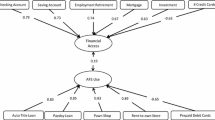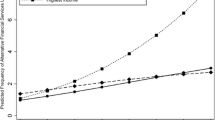Abstract
Many consumers use alternative financial service providers (AFSPs)—such as check cashing outlets, payday lenders, and pawnshops—to conduct some of their financial transactions. However, the fees for these services tend to be higher than those charged at mainstream financial institutions. One rationale why consumers continue to patronize them is that AFSPs serve the financial needs of patrons by filling a void created by the absence of traditional financial institutions—known as the spatial void hypothesis. Two studies have tested the spatial void hypothesis and reached opposing conclusions. While the most recent inquiry used alternative statistical methods to find support for the spatial void hypothesis in the counties investigated, questions arise as to its applicability to other geographical areas. This study applies the alternative methodology to examine the spatial void hypothesis in selected counties in the states of New Jersey and Delaware. It formulates appropriate null hypotheses of “indistinguishability” and tests these hypotheses by Monte Carlo methods and finds further support for the spatial void hypothesis.








Similar content being viewed by others
Notes
Kelsky (2003).
Jalili (2006).
It should be kept in mind that not all AFSPs offer all of these services. The services offered vary by the type of AFSP.
Sawyer and Temkin (2004).
An anonymous referee suggested the following more precise definition of the spatial void hypothesis that involves a two-stage approach: In stage 1, identify “bank voids” as locations whether there are fewer banks than would be expected given local population sizes, and in stage 2, determine whether there are significantly more AFSPs in these locations than would be expected by chance alone. This definition should be borne in mind in further research.
Smith et al. (2008).
Ibid., p. 206.
Two of the co-authors work at the Reserve Bank that serves the Federal Reserve’s Third District, which includes New Jersey and Delaware. Much of their research concerns activities and issues in the third district. Thus, we limited our focus here on these two states. In the future, we plan to consider other states.
The methodological exposition used here follows that utilized by SS&W with some modifications.
In future work, we will separate check cashers and pawnbrokers, in order to isolate the relative impact of cash checkers and banks.
See Sawyer and Temkin (2004), p. 7.
See Levine (2002).
See Ripley (1976).
This notion of “indistinguishability” is discussed further in the Market Demand Side section of the paper.
It should be noted that New Jersey limits the maximum interest rate charged by payday lenders to 30 % per annum.
This is because clustering is defined relative to area rather than population, as discussed further below.
For a discussion of dispersion ellipse, see SS&W (2008), p. 209.
It is worth noting that this is a case of the general class of LISA statistics offered by Anselin (1995).
Duranton and Overman (2005) used this type of local clustering analysis to study the clustering of firms.
Figure 3 also illustrates “edge effects” alluded to earlier. Given the proximity of \(x_i^0\) to the boundary, the designated region does not contain the entire circle of radius d . As mentioned previously, NNHC procedure ignores edge effects, while the SS&W approach (with the use of simulations) take them into account.
As far as the one-mile radius value is concerned, we performed robustness checks by using the following different radii (in terms of miles): .25, .50, .75, 1.00, and 1.50. Consequently, the results of all the counties were robust.
Here it is also important to note that rather than “dispersion ellipses,” cluster boundaries in the \(K\)-function approach of SS&W are defined by the union of one-mile circles around each significant institution location. In this way, all institutions contributing to the significance of these locations are automatically included in the cluster. This convention also helps to identify cluster “shapes” as well as their size.
For a derivation of the individual accessibility function, see SS&W (2008), pp. 216–217.
In other words, if the location behavior were truly indistinguishable, the expected income difference would be zero.
SS&W (2008), p. 217.
Ibid., p. 218.
The second column in Table 3 shows the number of block-groups with significantly higher accessibility to AFSPs relative to banks at the .01 level.
SS&W (2008), pp. 224–225.
References
Anselin L (1995) Local indicators of spatial association: LISA. Geogr Anal 27:93–116
Duranton G, Overman H (2005) Testing for localization using micro-geographic data. Rev Econ Stud 72:1077–1106
Jalili MH (2006) Unbanked: why some say the time is now. American Banker, June 7
Kelsky RB (2003) Securing customer dignity. Cheklist, p 36, 38
Levine N (2002) CrimeStat II. The National Institute of Justice, Washington, DC
Li W, Parrish L, Ernst K, Davis D (2009) Predatory Profiling: the role of race and ethnicity in the location of payday lenders. Center for Responsible Lending
Morgan DP, Pan KJ (2012) Do payday lenders target minorities. Federal Reserve Bank of New York
Ripley BD (1976) The second-order analysis of stationary point patterns. J Appl Probab 13:255–266
Sawyer N, Temkin K (2004) Analysis of alternative financial service providers. The Fannie Mae Foundation, Washington, DC
Skiba P, Tobacman J (2011) Do payday loans cause bankruptcy? Vanderbilt University
Smith TE, Smith MM, Wackes J (2008) Alternative financial service providers and the spatial void hypothesis. Reg Sci Urban Econ 38:205–227
Author information
Authors and Affiliations
Corresponding author
Rights and permissions
About this article
Cite this article
Smith, M.M., Wackes, J. & Smith, T.E. A note on alternative financial service providers and the spatial void hypothesis. Ann Reg Sci 51, 575–591 (2013). https://doi.org/10.1007/s00168-012-0549-6
Received:
Accepted:
Published:
Issue Date:
DOI: https://doi.org/10.1007/s00168-012-0549-6




